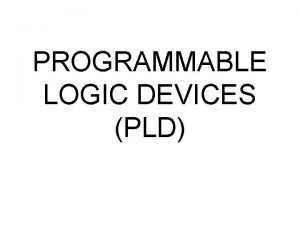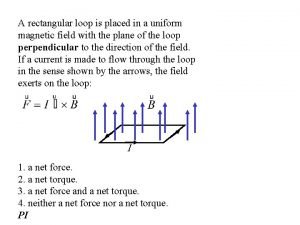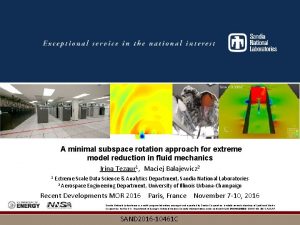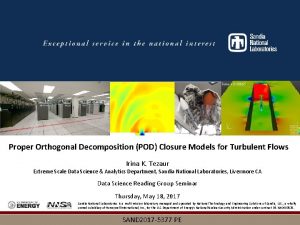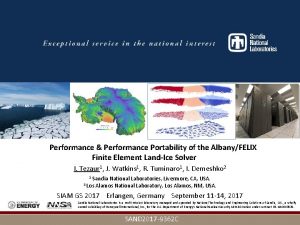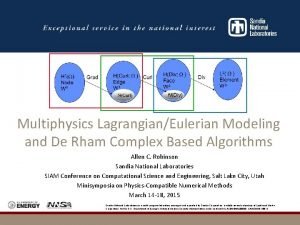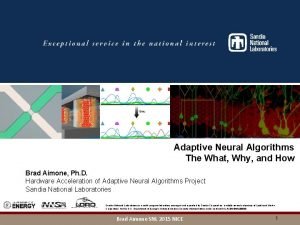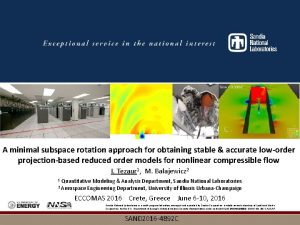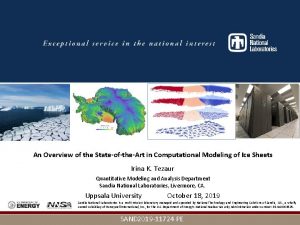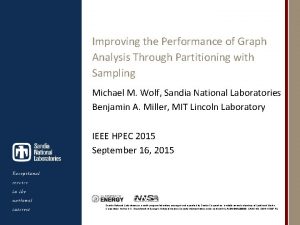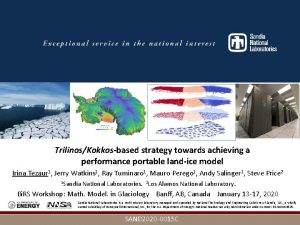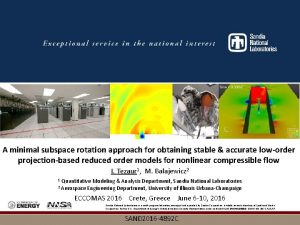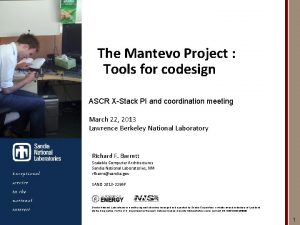Photos placed in horizontal position with even amount

























- Slides: 25

Photos placed in horizontal position with even amount of white space between photos and header Kokkos’ Multidimensional Array and Future Directions for std: : array_ref C++ Now 2016 May 9 -14, 2016 H. Carter Edwards SAND 2016 -4353 C Sandia National Laboratories is a multi-program laboratory managed and operated by Sandia Corporation, a wholly owned subsidiary of Lockheed Martin Corporation, for the U. S. Department of Energy’s National Nuclear Security Administration under contract DE-AC 04 -94 AL 85000. SAND NO. 2011 -XXXXP

Part 1: Kokkos Inspiration for array_ref Part 2: Future Directions for array_ref Six years of lessons learned with Kokkos

LAMMPS Albany Drekar EMPRESS SPARC What is Kokkos? Applications & Libraries Trilinos Kokkos performance portability for C++ applications DDR HBM HBM DDR Multi-Core Many-Core APU DDR CPU+GPU Cornerstone for performance portability across next generation HPC architectures at multiple DOE laboratories, and other organizations. 2

What is Kokkos? § κόκκος (Greek, not an acronym) § Translation: “granule” or “grain” ; like grains of sand on a beach § Performance Portable Thread-Parallel Programming Model § E. g. , “X” in “MPI+X” ; not a distributed-memory programming model § Application identifies its parallelizable grains of computations and data § Kokkos maps those computations onto cores and that data onto memory § Fully Performance Portable Library Implementation using C++11 § Not a language extension (e. g. , Open. MP, Open. ACC, Open. CL, …) § Open source at https: //github. com/kokkos ü Multicore CPU - including NUMA architectural concerns ü Intel Xeon Phi (KNC) – toward DOE’s Trinity (ATS-1) supercomputer ü NVIDIA GPU (Kepler) – toward DOE’s Sierra (ATS-2) supercomputer ² IBM Power 8 – toward DOE’s Sierra (ATS-2) supercomputer ² AMD Fusion – back-end in collaboration with AMD via HCC ü Regularly tested ² Ramping up testing 3

Abstractions: Patterns, Policies, and Spaces § Parallel Pattern of user’s computations § parallel_for, parallel_reduce, parallel_scan, task-graph, . . . (extensible) § Execution Policy tells how user computation will be executed § Static scheduling, dynamic scheduling, thread-teams, . . . (extensible) § Execution Space tells where user computations will execute § Which cores, numa region, GPU, . . . (extensible) § Memory Space tells where user data resides § Host memory, GPU memory, high bandwidth memory, . . . (extensible) § Layout (policy) tells how user array data is laid out in memory § Row-major, column-major, array-of-struct, struct-of-array … (extensible) § Differentiating: Layout and Memory Space § Versus other programming models (Open. MP, Open. ACC, …) § Critical for performance portability … 4

Examples of Execution and Memory Spaces Compute Node Multicore Socket preferred Attached Accelerator GPU DDR preferred shared GDDR deep_copy Attached Accelerator Compute Node Multicore Socket preferred DDR GPU: : pinned shared GPU: : UVM 5 GPU preferred GDDR

Layout Abstraction: Multidimensional Array § Classical (50 years!) data pattern for science & engineering codes § Computer languages hard-wire multidimensional array layout mapping § Problem: different architectures require different layouts for performance Ø Leads to architecture-specific versions of code to obtain performance § E. g. , “Array of Structure” ↔ “Structure of Array” redesigns e. g. , “row-major” CPU caching e. g. , “column-major” GPU coalescing § Kokkos separates layout from user’s computational code § Choose layout for architecture-specific memory access pattern Ø Without modifying user’s computational code § Polymorphic layout via C++ template meta-programming (extensible) Ø e. g. , Hierarchical Tiling layout (array of structure of array) § Bonus: easy/transparent use of special data access hardware § Atomic operations, GPU texture cache, . . . (extensible) 6

Performance Impact of Data Layout Molecular dynamics computational kernel in mini. MD Simple Lennard Jones force model: Atom neighbor list to avoid N 2 computations pos_i = pos(i); for( jj = 0; jj < num_neighbors(i); jj++) { j = neighbors(i, jj); r_ij = pos(i, 0. . 2) – pos(j, 0. . 2); // random read 3 floats if (|r_ij| < r_cut) f_i += 6*e*((s/r_ij)^7 – 2*(s/r_ij)^13) } f(i) = f_i; Test Problem 864 k atoms, ~77 neighbors 2 D neighbor array Different layouts CPU vs GPU Random read ‘pos’ through GPU texture cache Large performance loss with wrong data layout 7 200 correct layout (with texture) 150 GFlop/s correct layout (without texture) 100 50 wrong layout (with texture) 0 Xeon Phi K 20 x

Performance Overhead? Kokkos is competitive with other programming models § Regularly performance-test mini-applications on Sandia’s ASC/CSSE test beds § Mini. FE: finite element linear system iterative solver mini-app § Compare to versions with architecture-specialized programming models Time (seconds) 24 Mini. FE CG-Solve time for 200 iterations on 200^3 mesh 20 16 12 8 4 0 K 20 X Ivy. Bridge Sandy. Bridge Xeon. Phi B 0 Xeon. Phi C 0 IBM Power 7+ NVIDIA ELL NVIDIA Cu. Sparse Kokkos Open. MP MPI-Only Open. CL TBB Cilk+(1 Socket) 8 8

Performance Portability & Future Proofing Integrated mapping of users’ parallel computations and data through abstractions of patterns, policies, spaces, and layout. § Versus other thread parallel programming models (mechanisms) § Open. MP, Open. ACC, Open. CL, . . . have parallel execution § Open. MP 4 finally has execution spaces; when memory spaces ? ? Ø All of these neglect data layout mapping § Requiring significant code refactoring to change data access patterns § Cannot provide performance portability Ø All require language and compiler changes for extension § Kokkos extensibility “future proofing” wrt evolving architectures § Library extensions, not compiler extensions § E. g. , Intel KNL high bandwidth memory ← just another memory space 9

Mapping Parallel Computations § Pattern composed with policy drives execution of closure pattern policy closure Kokkos: : parallel_for ( N , [=]( int i ) { /* body */ } ); § Data parallel patterns § Kokkos: : parallel_for § Kokkos: : parallel_reduce § Kokkos: : parallel_scan § Data parallel execution policies § Kokkos: : Range. Policy< Exec. Space >( integral_begin , integral_end ) § Kokkos: : Team. Policy< Exec. Space >( league_size , team_size ) § N implies Kokkos: : Range. Policy< Default. Exec. Space >( 0 , N ) § Simplicity of use is comparable to Open. MP § Reduce is far simpler to customize than Open. MP § Scan is not even an option in Open. MP 10

Mapping Execution onto Exec. Space § Markups for Exec. Space Portability § CUDA: #define KOKKOS_FUNCTION __device__ __host__ Ø Lambda capture markup supported in CUDA 8. 0, came about through intense prodding of NVIDIA by DOE laboratories Ø Exposed the now resolved (C++17) lambda-capture-*this issue § HCC: #define KOKKOS_FUNCTION __attribute__((amp, cpu)) § CPU: #define KOKKOS_FUNCTION /* nothing needed */ § Mapping Range. Policy i �[0. . N) § CUDA Space: i = thread. Idx + block. Dim * block. Idx ; strided partitions § CPU Space: i [begin, end)Th ; contiguous partitions to threads § Inter-thread computations for value of reduce and scan § Thread-local values for partial sums (or other reduction operator) § Inter-thread join of thread-local values § User extensible type, init, and join of reduction value 11

Kokkos’ Multidimensional Array View § Development started 2010, predates array_ref proposal § Kokkos: : View< double**[3][8] , Space > a(“a”, N, M); § Allocate array data in memory Space with dimensions [N][M][3][8] § For compact syntax dynamic dimensions denoted by * Ø Initially got away with [] until warnings-as-errors § a(i, j, k, l) : User’s access to array datum § “Space” accessibility enforced; e. g. , GPU code cannot access CPU memory § Optional array bounds checking of indices for debugging § View Semantics: View<double**[3][8], Space> b = a ; § Analogous to std: : shared_ptr § A shallow assignment: ‘a’ and ‘b’ are references to the same allocated data § Kokkos: : deep_copy( destination_view , source_view ); § Copy data from ‘source_view’ to ‘destination_view’ Ø Kokkos policy: make expensive deep copy operations very obvious 12

Polymorphic Multidimensional Array Layout § Layout mapping : a(i, j, k, l) → memory location § Layout is polymorphic, defined at compile time § Kokkos chooses default array layout appropriate for “Space” § E. g. , row-major, column-major, Morton ordering, dimension padding, . . . § User can specify Layout : View< Array. Type, Layout, Space > § Override Space’s preferred array layout § Why? For compatibility with legacy code, algorithmic performance tuning, . . . § Example Tiling Layout § View<double**, Tile<8, 8>, Space> m(“matrix”, N, N); § Tiling layout transparent to user code : m(i, j) unchanged § Layout-aware algorithm extracts tile subview 13

Multidimensional Array Subview & Properties § Array subview of array view § § Y = subview( X , . . . ranges_and_indices_argument_list. . . ); View of same data, with the appropriate layout and index map Each index argument eliminates a dimension Each range [begin, end) argument contracts a dimension § pair<i. Type, i. Type>(begin, end) or { begin , end } § Access intent Properties View< Array. Type, Layout, Space, Access. Properties > § How user intends to access datum § Example, View with const and random access intension § View< double ** , Cuda > a(“mymatrix”, N, M ); § View< const double **, Cuda, Random. Access > b = a ; Ø Kokkos implements b(i, j) with GPU texture cache 14

Managing Memory Access Pattern: Compose Parallel Execution ○ Array Layout § Recall mapping of parallel execution § Maps calls to closure(iw) onto threads § GPU: iw = thread. Idx + block. Dim * block. Ids § CPU: iw [begin, end)Th ; contiguous partitions among threads § Choose array layout § Leading dimension is parallel work dimension § Leading multi-index is ‘iw’ : a( iw , j, k, l ) § Choose appropriate array layout for space’s architecture § E. g. , row-major for CPU and column-major for GPU § Fine-tune Array Layout § E. g. , padding dimensions for cache line alignment 15

Part 1: Kokkos Inspiration for array_ref Part 2: Future Directions for array_ref Six years of lessons learned with Kokkos

Compact (Relaxed) Array Type Declaration § array_ref< T , array_property: : dimension< …dims > > § Very user unfriendly § Especially for mathematicians, engineers, and scientists – target stakeholders § Especially if using array_property: : dynamic_extent § experience a rank-6 array_ref with 5 dynamic extents § array_ref< T[][][][3] > // preferred syntax § Original syntax for Kokkos worked well, until warnings-as-errors § Kokkos users universally preferred this syntax § LEWG had consensus on preferring this syntax § Preferred syntax requires trivial change to language § One line change to Clang to stop generating an error § Accepted by gcc until v 5 (without warnings-as-errors) § Well-defined change to Arrays paragraph : n 4567 p 8. 3. 4. p 3 Ø Omission of any static bound after the first defines an incomplete object type 17

When array_ref: : reference does not alias an lvalue reference § Recall: Kokkos: : View< const Array. Type , Cuda, Random. Access > § operator()(i, j, …) reads data through GPU texture cache § return by value, not by const lvalue reference § not lvalue reference => disallowed to &a(i, j, k) § Another use case: Kokkos: : View< Array. Type , Space , Atomic > § operator()(i, j, …) returns an atomic view concept (P 0019) proxy § allowed to a(i, j, k). fetch_add(value) § Perhaps for convenience: array_ref { static constexpr bool is_lvalue_reference_v = std: : is_lvalue_reference_v< reference > ; } 18

Shared Ownership and Allocating Constructor § Users appreciate View’s shared ownership and allocating ctor § Reference to array data semantics preserved § Users have a single interface, avoid juggling multiple objects § Avoids multistep allocation process: compute size, allocate, wrap § array_ref< … , array_property: : Shared > template < class D , class A > array_ref( D , A , pointer , dimensions. . . ); § Conformal to std: : shared_ptr deleter and allocator template < class A > array_ref( A , dimensions… ); § Allocate, initialize, destroy, and deallocate via A use_count() const noexcept ; § Conformal to std: : shared_ptr § As if data member was std: : shared_ptr instead of pointer 19

Memory Space (Memory Resource) § Modern architectures have non-trivial memory spaces § § DDR NUMA regions on CPU GDDR and programmable L 1 (a. k. a. , __shared__ memory) on GPU HBM, NVRAM, … … with kernel properties; e. g. , GPU UVM, pinned § Use concept of C++17 memory_resource for memory spaces § Safety and performant utilization requires type information § When can/cannot be accessed, specialized instructions § is_memory_resource< Space > § array_ref< … , Space > array_ref( Space , dimensions… ); § Allocate and deallocate via Space & memory_resource() const noexcept ; 20

Performance Hint Properties § In the current scope … § array_ref< … , array_property: : Restrict > § Declares exclusive reference to array elements § array_ref< … , array_property: : Once > § Declares elements are accessed only once and need not be cached § array_ref< … , array_property: : Random > § Declares elements are accessed essentially randomly § Recall Kokkos’ GPU + const + Random => use texture cache § array_ref< … , array_property: : Check. Bounds > § Indexing operator performs bounds checking § … alternative to [[attribute-list]] on array objects § … boundless opportunities for bike-shedding names 21

array_ref Property Pack Management § For ease of use, apply and remove meta functions § array_property: : apply< array_ref<…> , property >: : type § Add property to the array_ref property pack § array_property: : remove< array_ref< … > , property >: : type § Remove property from the array_ref property pack § Assignability with non-identical properties template< typename UT , class … UP , typename VT , class … VP > array_property: : is_assignable< array_ref<UT, UP…> , array_ref<VT, VP…> > § Conceptually analogous to cv-qualification rules § Compatibility of data type, rank, static dimensions, layout, … 22

User Defined Layout: : mapping § array_ref may be optimized for standard layouts § User defined Layout: : mapping is a common need § Tiling, symmetric tensor folding, space filling curve, … § Concept of Layout: : mapping for performant extensibility § § indexing: constexpr size_type offset( … indices ) const noexcept ; construct: mapping( … dynamic_dimensions ), mapping( layout ) domain properties: rank(), extent(i) range properties: is_regular(), is_contiguous(), span(), stride(i) § One catch: integration with subarray is challenging § Optimization is work-in-progress within Kokkos library 23

Future Directions: Priorities and Plans 1. Start with foundational capability § Property pack limited to § dimension § Predefined standard layouts 2. Relax array incomplete type declaration: T[ ][3][ ] 3. Shared ownership property with allocating constructors § Also property pack management: apply, remove 4. Memory space property with memory resource § Requires memory space concept 5. Performance hint properties 6. Extensible layout § More experience needed with subarray integration 24
 Glisside
Glisside Triangular prism faces edges vertices
Triangular prism faces edges vertices Regular expression recursive definition
Regular expression recursive definition Regular expression of even even language
Regular expression of even even language Fca welding practice plates thicker than 1/2 inch ____.
Fca welding practice plates thicker than 1/2 inch ____. Horizontal recumbent position
Horizontal recumbent position Lithotomy position
Lithotomy position Dorsal recumbent
Dorsal recumbent Fundamental position vs anatomical position
Fundamental position vs anatomical position Fundamental positions
Fundamental positions Mia placed point p on the number line
Mia placed point p on the number line Personal protective equipment for smaw
Personal protective equipment for smaw The impression placed on the inner surface of a barrel
The impression placed on the inner surface of a barrel On what tooth structure is calcium hydroxide placed
On what tooth structure is calcium hydroxide placed A heater is placed under one corner
A heater is placed under one corner The curved sealed edge between floor and wall
The curved sealed edge between floor and wall Major connector maxillary
Major connector maxillary Trecs local gov clearinghouse phone number
Trecs local gov clearinghouse phone number Comfort devices introduction
Comfort devices introduction If an effective ceiling price is placed on hamburgers, then
If an effective ceiling price is placed on hamburgers, then Pld examples
Pld examples A rectangular loop is placed in a uniform magnetic field
A rectangular loop is placed in a uniform magnetic field What happens when like poles are placed together
What happens when like poles are placed together Whenever possible, child car safety seats should be placed
Whenever possible, child car safety seats should be placed How does archimedes principle relate to convection
How does archimedes principle relate to convection Most colonists placed a high value on education
Most colonists placed a high value on education




















